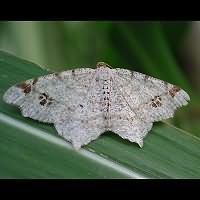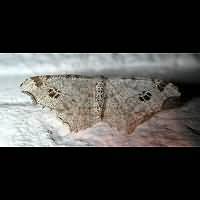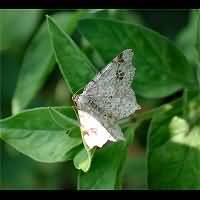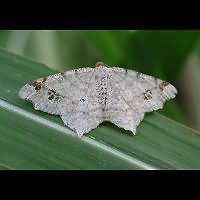Peacock Moth (Macaria notata)
There is only one species similar to the Peacock Moth: the Sharp-angled Peacock Moth. Both are quite light, have a brown spot on the edge of the wing and a bigger and darker spot a little further on and the hindwings are angled. The Peacock Moth usually is much whiter than the Sharp-angled Peacock. The Peacock also has a thin greyish line running just above the brown and blackish dots. In the Sharp-angled Peacock these spots are within a broad, greyish band. The shape of the angled hind wings differs also and the Sharp-angled Peacock has the concave part of the forewing, just below the tip of the wing, entirely dark brown, including the fringes. The Peacock just has a (much lighter) brown line there, which does not effect the fringes. Once you have seen them both together, you usually can tell them apart by their shape. However very worn species can sometimes be puzzling. The wingspan of the Peacock Moth is 28 to 32 mm.
The caterpillar is green having a brown back. On the sides we usually see a few yellow spots with two smaller black dots in them. The head may be green, but is brown usually. It is not very variable and may reach a length of some 24 mm. The caterpillars are fast growing, for the eggs are deposited in June and the first new adults already appear in July. The larvae of the summergeneration can be seen in September mainly, and pupate underground in October. The pupa then overwinters. The larvae are found on birch and willow.
The Peacock Moth is single-brooded in Scotland, Wales and Northern England, double-brooded in Southern England. It is regularly seen during day time resting on the leaves of shrubs and easily disturbed, but on the wing during night time only. Comes sparingly to light. A local species in Britain, even though it may appear in great numbers. It is more common on the continent.
Scientifically this species is also known as Semiothisa notata.
There is only one species similar to the Peacock Moth: the Sharp-angled Peacock Moth. Both are quite light, have a brown spot on the edge of the wing and a bigger and darker spot a little further on and the hindwings are angled. The Peacock Moth usually is much whiter than the Sharp-angled Peacock. The Peacock also has a thin greyish line running just above the brown and blackish dots. In the Sharp-angled Peacock these spots are within a broad, greyish band. The shape of the angled hind wings differs also and the Sharp-angled Peacock has the concave part of the forewing, just below the tip of the wing, entirely dark brown, including the fringes. The Peacock just has a (much lighter) brown line there, which does not effect the fringes. Once you have seen them both together, you usually can tell them apart by their shape. However very worn species can sometimes be puzzling. The wingspan of the Peacock Moth is 28 to 32 mm.
The caterpillar is green having a brown back. On the sides we usually see a few yellow spots with two smaller black dots in them. The head may be green, but is brown usually. It is not very variable and may reach a length of some 24 mm. The caterpillars are fast growing, for the eggs are deposited in June and the first new adults already appear in July. The larvae of the summergeneration can be seen in September mainly, and pupate underground in October. The pupa then overwinters. The larvae are found on birch and willow.
The Peacock Moth is single-brooded in Scotland, Wales and Northern England, double-brooded in Southern England. It is regularly seen during day time resting on the leaves of shrubs and easily disturbed, but on the wing during night time only. Comes sparingly to light. A local species in Britain, even though it may appear in great numbers. It is more common on the continent.
Scientifically this species is also known as Semiothisa notata.







